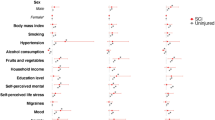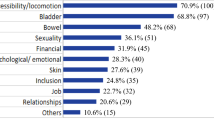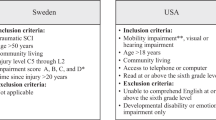Abstract
Leisure activity profiles of 81 male and 21 female SCI subjects were compared with profiles of 135 male and 151 female non-disabled individuals. These profiles, derived from the Leisure Activities Blank (McKechnie, 1985), revealed that SCI subjects had been more physically active (prior to injury) than those in a non-disabled comparison group; however, their post-injury expectations for future leisure activity involvement were considerably lower than a similar study of non-disabled individuals. These reduced expectations were found for both active and sedentary activity categories. It is suggested that awareness of pre-morbid leisure activity profiles, plus recognition that post-injury expectations for leisure activity participation are often reduced, could assist medical personnel to prescribe treatment or offer programmes that enable SCI patients to maintain their pre-morbid lifestyles and enhance future leisure activity expectations.
Similar content being viewed by others
Log in or create a free account to read this content
Gain free access to this article, as well as selected content from this journal and more on nature.com
or
References
Buchanan L E, Nawzenski, D A 1987 Spinal cord injury: Concepts and management approaches, Williams & Wilkins, Maryland.
Krause J S, Crewe N M 1987 Prediction of long-term survival of persons with spinal cord injury: An 11-year prospective study. Rehabilitation Psychology 32: 203–213.
Macdonald M R, Nielson, W R, Cameron, M G P 1987 Depression and activity patterns of spinal cord injured persons living in the community. Archives of Physical Medicine and Rehabilitation 68: 339–343.
McKechnie, G F 1975 Manual for Leisure Activities Blank. Consulting Psychologists Press, Palo-Alto, California.
Meyers A R, Feltin M, Master R J et al. 1985 Rehospitalization and spinal cord injury: Cross-sectional survey of adults living independently. Archives of Physical Medicine and Rehabilitation 66: 704–708.
McGowan M B, Roth S 1987 Family functioning and functional independence in spinal cord injury adjustment. Paraplegia 25: 357–365.
Norris-Baker C, Stephens M A P et al. 1981 Patient behavior as predictor of outcomes in spinal cord injury. Archives of Physical Medicine and Rehabilitation 62: 602–608.
Swanson E 1976 The relationship between locus-of-control expectancy and successful rehabilitation of the spinal cord injured. Unpublished doctoral dissertation, Arizona State University, Tempe, USA.
Trieschmann R B 1980 Spinal cord injuries: Psychological, Social and Vocational Adjustment. Pergamon Press, New York.
Author information
Authors and Affiliations
Rights and permissions
About this article
Cite this article
Kennedy, D., Smith, R. A comparison of past and future leisure activity participation between spinal cord injured and non-disabled persons. Spinal Cord 28, 130–136 (1990). https://doi.org/10.1038/sc.1990.15
Issue date:
DOI: https://doi.org/10.1038/sc.1990.15



